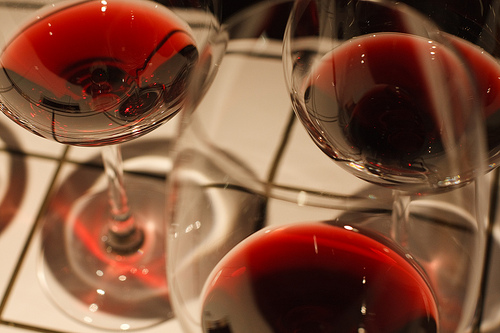
primary-image, l
Top | While my sautoir gently sweats — Blog
(post, John Dryzga)

primary-image, l
The wine snob raises the glass of wine, swirls it deftly, as his nose probes for all its secret aromas. He takes a sip, swishes it around his mouth and spits it out into the waiting bucket. He proceeds to describe the wine in prose even more purple than the permanent wine stains on his teeth. Then, as a finale, he declares the exact grape, area, producer and vintage of the wine. The crowd is stunned with awe in witnessing such an amazing feat. The above is the cliched version of blind tasting. To actually get such an amazing amount of detail correct is more the exception than the rule, but if you pay attention to what's in your glass, it's amazing on how close you can get to the above scene. Hopefully, sans stained teeth. Last night, Fred Dexheimer, a Master Sommelier, gave a class in blind tasting at the Astor Center. To get the Master Sommelier certification, one must pass a grueling test consisting of general wine knowledge, wine service and a blind tasting of six wines. Only about 100 people in the US have this designation and most people who have it took the exams several time to pass it. So, I was ready to absorb whatever knowledge he had to impart. Fred started off with a brief description of how wine is made. He had a great slide using Pacman to demonstrate how yeast eats sugar to make alcohol. Right then, I knew this was going to be a great class. As he moved through the steps of tasting a wine, he was framing the lessons in the context of discerning more about the mystery in your glass. How the color of the wine changes with age so you can at least place the vintage of the wine into newer or older. He talked about how climate affected the alcohol level and viscosity of wine. You could then use this information to place the wine into a warm growing region or a cool growing region. Is the nose of the wine more fruity or more earthy? This gives you important clues into whether it is a wine from the Old World or a New World upstart. We finally got to put our new wine tasting acumen to the test by blind tasting seven wines. I know, I know, it was a tough assignment, but you have to do what you have to do. The wines were all from standard grapes and regions so they be great wines to cut our blind tasting teeth(taste buds?) on. We worked our way through the wines starting with three white wines. Fred led us through the FEW TAL tasting steps. That is Fruit, Earth, Wood, Tannin, Acid, and Length. The class no problem of identifying the first wine as a New Zealand sauvignon blanc. We soon started sipping and zipping our way through the wines, throwing around adjectives like barnyard and pencil lead like the most jaded wine critic. We did great in identifying the wines. Only the last one had the class a little confused, about half thought it was a Zinfandel, the other half a Syrah. I was in the Zin camp myself and was a little disappointed to see it was indeed the Syrah. This was a really fun and informative class. Fred Dexheimer proved to be a great instructor, making the material really fun to learn. Now please excuse me, I have blind wine tasting to practice.